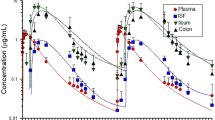Abstract
The effects of the β-agonist ractopamine, recently approved for use in feedlot cattle to improve carcass quality and performance, on fecal shedding Escherichia coli O157:H7 and Salmonella in feedlot cattle was examined. In the first study, 20 feedlot steers and heifers were randomly assigned to receive ractopamine or no ractopamine (control) by way of oral bolus for 28 days. Fecal samples were collected daily, and shedding of E. coli O157:H7 determined. When examined during the entire 28-day experimental period, ractopamine decreased (P = 0.0006) the percentage of cattle shedding E. coli O157:H7 (58% vs. 42% for control and ractopamine treatments, respectively). A second study was conducted in a commercial feedlot facility in the southwestern United States. Eighteen pens of cross-bred beef heifers (approximately 100 head/pen and 9 pens/treatment) were randomly assigned to receive either 0 (control) or 200 mg ractopamine/head·d–1. Fresh fecal samples (30/pen) were collected off the pen floor before ractopamine supplementation and again after approximately 28 days of ractopamine supplementation (within a few days of slaughter); the samples were cultured for E. coli O157:H7 and Salmonella. The percentage of animals shedding E. coli O157:H7 was decreased when data were pooled across replicates (P = 0.05) in ractopamine-treated cattle compared with controls. The percentage of animals shedding Salmonella tended to be higher (P = 0.08) with the ractopamine treatment when data were pooled across replicates. Although further research is required to confirm these results, the potential food safety implications of this research are intriguing.



Similar content being viewed by others
Literature Cited
Sperandio V, Torres AG, Giron JA, et al. (2001) Quorum sensing is a global regulatory mechanism in enterohemorrhagic Escherichia coli O157:H7. J Bacteriol 183:5187–5197
Sperandio V, Torres AG, Jarvis B, et al. (2003) Bacteria-host communication: The language of hormones. Proc Nat Acad Sci U S A 100:8951–8956
Freestone PP, Williams PH, Haigh RD, et al. (2002) Growth stimulation of intestinal commensal Escherichia coli by catecholamines: A possible contributory factor in trauma-induced sepsis. Shock 18:465–470
Lyte M, Frank CD, Green BT (1996) Production of an autoinducer of growth by norepinephrine cultured Escherichia coli O157:H7. FEMS Microbiol Lett 139:155–159
Lyte M, Erickson AK, Arulanandam BP, et al. (1997) Norepinephrine-induced expression of the K99 pilus adhesion of enterotoxigenic Escherichia coli. Biochem Biophys Res Commun 232:682–686
Ricks CA, Baker PK, Dalrymple RH (1984) Use of repartitioning agents to improve performance and body composition of meat animals. Proc Reciprocal Meat Conf 37:5–11
Moody DE, Hancock DL, Anderson DB (2000) Phenethanolamine repartitioning agents. In: D’Mello JPF (ed) Farm animal metabolism and nutrition. New York, NY: CAB Int., pp 65–95
Anderson DB, Veenhizen EL, Waitt WP, et al. (1987) Effect of ractopamine on nitrogen retention, growth performance and carcass composition of finisher pigs. J Anim Sci 65(Suppl. 1; Abstr.):130
Watkins LE, Jones DJ, Mowrey DH, et al. (1990) The effect of various levels of ractopamine hydrochloride on the performance and carcass characteristics of finishing swine. J Anim Sci 68:3588–3595
Mersmann HJ (1998) Overview of the effects of B-adrenergic receptor agonists on animal growth including mechanisms of action. J Anim Sci 76:160–172
Keen JE, Elder RO (2002) Isolation of shiga-toxigenic Escherichia coli O157 from hide surfaces and the oral cavity of finished beef feedlot cattle. J Am Vet Med Assoc 220:756–763
Blum JW, Flueckiger N (1988) Early metabolic and endocrine effects of perorally administered β-adrenoreceptor agonists in calves. Eur J Pharmacol 151:177–187
Edrington TS, Schultz CL, Callaway TR, et al. (2005) Effect of exogenous melatonin on fecal shedding of E. coli O157:H7 in naturally-infected beef cattle. Proceedings of the 15th International Congress of Comparative Endocrinology, May 22–27, 2005, Boston, MA, p 65
Sudgen D, Klein DC (1985) Regulation of rat pineal α-1 adrenoreceptors. J Neurochem 44:63–67
Alphs L, Lovenberg W (1984) Modulation of rat pineal acetyl-CoA: Arylamine N-acetyltransferase induction by alpha adrenergic drugs. J Pharmacol Exp Ther 230:431–437
Vieira R, Miguez J, Lema M, et al. (1992) Changes in pineal and serum melatonin induced by α-1 and β-adrenoceptor agonists: Day and night differential responsiveness. Neuroendocrinol Lett 6:429–438
Chapman PA, Siddons CA, Cerdan Malo AT, et al. (1997) A 1-year study of Escherichia coli O157 in cattle, sheep, pigs and poultry. Epidemiol Infect 119:245–250
Elder RO, Keen JE, Siragusa GR, et al. (2000) Correlation of enterohemorrhagic Escherichia coli O157 prevalence in feces, hides, and carcasses of beef cattle during processing. Proc Nat Acad Sci U S A 97:2999–3003
Corrier DE, Purdy CW, DeLoach JR (1990) Effects of marketing stress on fecal excretion of Salmonella spp in feeder calves. Am J Vet Res 51:866–869
Beach JC, Murano EA, Acuff GR (2002) Prevalence of Salmonella and Campylobacter in beef cattle from transport to slaughter. J Food Prot 65:1687–1693
Vlisidou I, Lyte M, van Diemen PM, et al. (2004) The neuroendocrine stress hormone norepinephrine augments Escherichia coli O157:H7-induced enteritis and adherence in a bovine ligated ileal loop model of infection. Infect Immun 72:5446–5451
Acknowledgments
The investigators gratefully thank K. Andrews and R. Street for excellent technical expertise.
Author information
Authors and Affiliations
Corresponding author
Additional information
Mention of trade name, proprietary product, or specific equipment does not constitute a guarantee or warranty by the United States Drug Administration and does not imply its approval to the exclusion of other products that may be suitable.
Rights and permissions
About this article
Cite this article
Edrington, T.S., Callaway, T.R., Ives, S.E. et al. Effect of Ractopamine HCl Supplementation on Fecal Shedding of Escherichia coli O157:H7 and Salmonella in Feedlot Cattle. Curr Microbiol 53, 340–345 (2006). https://doi.org/10.1007/s00284-006-0200-9
Received:
Accepted:
Published:
Issue Date:
DOI: https://doi.org/10.1007/s00284-006-0200-9




